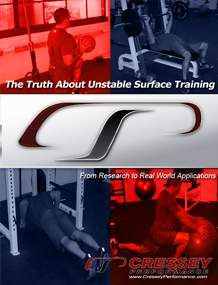What Really Constitutes Functional Balance Training?
Just a few days ago, a friend of mine passed along the link for a Reuters article reporting on a study that found that a 12-week Tai Chi intervention did not reduce the risk of falls in the elderly.
This might be surprising to some, as one would think that any sort of physical activity would benefit untrained elderly individuals. However, I wasn’t surprised at the results at all, given all the research I’d done to prepare for The Truth About Unstable Surface Training. And, I wasn’t surprised at all when I realized that this had significant parallels to how we train balancing proficiency in athletes.
It’s important to understand first and foremost that balance and proprioception (and, therefore, stability at a certain point in time) are skill-specific. In particular, one must appreciate that static balance – which is typical of Tai Chi – is markedly difference from dynamic balance, which we encounter all the time in everyday life and in the world of athletics.
For proof, one mustn’t look any further than when Drowatzky and Zuccato (1966) found little carryover from static to dynamic balance (1). Tsigilis et al. confirmed this finding 35 years later (2). And, it’s one reason why I feel so strongly that we have to qualify our unstable surface training (UST) recommendations. UST necessitates a significant amount of static balance that may not transfer to sporting movements, which typically are more dependent on dynamic balancing proficiency.
From my e-book on the subject, “Previous research has demonstrated that scores on static balance tests are not useful information when attempting to predict inversion ankle injuries in soccer players (3). This lack of correlation implies that methods to improve static balance may not be effective training approaches to prevent injuries in dynamic sporting contexts – especially when dealing with athletes with no recent history of lower extremity injury.”
Now, we know that we can’t train complete specificity 100% of the time. Otherwise, in the elderly, we’d be trying to simulate every kind of fall that is possible. And, in a football player, for instance, we’d be trying to simulate every kind of tackle a running back could possibly encounter. So, what do we do? Once again, we look to the research!
In a study by Bruhn et al., a high-intensity strength training group actually outperformed the unstable surface training (static balance training) group on measures of static balance (4). In other words, one group trained static balance, and the other didn’t – and the one who didn’t train static balance directly actually improved the most overall. Maybe muscle cross-sectional area played into it? Maybe it occurred because of increased stabilization via enhanced intra- and intermuscular coordination that would allow for more rapid and effective force production (strength and rate of force development)? Maybe true specificity isn’t as important as we thought?
Click here to purchase The Truth About Unstable Surface Training.
References
1. DROWATZKY, J.N., AND F.C. ZUCCATO. Interrelationships between selected measures of static and dynamic balance. Res. Q. 38:(3) 509-510. 1966.
2. TSIGILIS, N., E. ZACHOPOULOU, T. MAVRIDIS. Evaluation of the specificity of selected dynamic balance tests. Percept Mot Skills. 92(3 Pt 1):827-33. 2001.
3. KONRADSEN, L. Factors Contributing to Chronic Ankle Instability: Kinesthesia and Joint Position Sense. J Athl Train. 37(4):381-385. 2002.
4. BRUHN, S., N. KULLMANN, AND A. GOLLHOFER. The effects of a sensorimotor training and a strength training on postural stabilisation, maximum isometric contraction and jump performance. Int J Sports Med. 25(1):56-60. 2004.
Sign-up Today for our FREE Newsletter and receive a deadlift technique tutorial!




